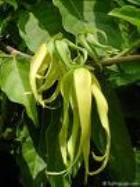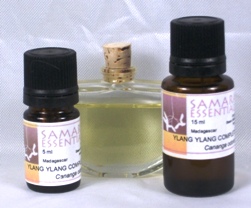
Plant Part: Flower
Extraction: Steam Distilled
Growing Practice: Organic
Country of Origin: Madagascar
Odor Type: FLORAL

Odor Characteristic:
Refractive Index: 1.49700 to 1.51100 @ 20.00 °C.
Specific Gravity: 0.94800 to 0.96800 @ 25.00 °C. | 0.926 @ 20 &C
Appearance: pale yellow clear liquid
BioChemical Class: Sesquiterpene
BioChemicals: Linalool (2.3%);β-caryiohyllene (17.7%);germacrene-D (19.3%); geranyl acetate (5.5%); benzyl benzoate (2.3%); benzyl salicylate (6.8%)
CAS No: 8006-81-3
INCI Name: CANANGA ODORATA FLOWER EXTRACT
About the Plant
Ylang ylang essential oils are derived by steam distillation from the freshly picked yellow/yellow-green flowers of the canaga tree (Cananga odorata of the Family Annonaceae. The fast-growing tree may reach 60 ft. in height, but is typically pruned to 4 feet to make it easier to harvest the blossoms. It grows in full or partial sun in the acidic soils of the native rainforest environment. Evergreen leaves are smooth and glossy, oval and pointed with wavy margins about 5-8 inches long. The flower is drooping, long stalked, with six narrow greenish-yellow petals. The ylang ylang (sometimes spelled ylang-ylang) tree is native to the Phillipines and Indonesia, but is also grown in Polynesia, Melanesia and Micronesia. Commercial production of the essential oil was originally in the Phillipines, Zanzibar, and Reunion, but the principle producers in the 21st century are Madagascar and the Commores islands.There are multiple grades of ylang ylang oil with varying quality depending on the time of distillation
History
The name "ylang-ylang" is derived from Tagalog (a language of the Phillipines) either from the word ilang meaning "wilderness" or the word ilang-ilan meaning "rare".Perfumery:![]()
The information provided on these pages is not a substitute for necessary medical care, nor intended as medical advice. Always keep aromatic extracts tightly closed and in a cool, dark place, out of reach of children. Never ingest aromatic extracts. Always dilute aromatic extracts when applying topically and avoid areas around eyes or mucous membranes. If redness or irritation occurs, stop using immediately and contact your health provider if necessary.![]()
all images and content copyright ©2000—2020 by suzumebachi design and samara botane





